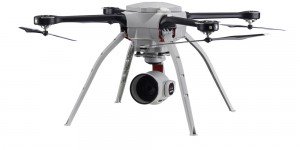The following is a guest post by technology writer Marla Keene, working for AXControl, Inc.
Imagine you’re the head of a public power utility system. Winter is coming, and you need to make sure your system’s hydroelectric power isn’t hampered by broken ice floes on the river system. Steel pontoons and cables have been installed by your team to hold the ice back, but they need to be inspected. Typically, this means an expensive, dangerous job done by boat or by helicopter.
But not this year. You’ve decided to use new drone technology to do the job. By doing so, you’re saving the company nearly 90% of the typical cost for inspection, not to mention keeping your employees’ feet safe on dry land.
This isn’t theoretical. Since 2017, NY Power Authority and Canadian utility OPG have partnered together to inspect the ice boom located between Lake Erie and the Niagara River. The drone, an Aeryon SkyRanger UAV, projects high-resolution images and other data to operators who have the option to record video if necessary to properly monitor issues and schedule repairs.
While the adoption of drone technology has been slow in the industrial sector, companies are now beginning to explore all options of these machines. The inspection capabilities like those mentioned above will have a far-reaching impact on many industries. Drones can be used to execute visual inspections to the physical resources of a business, such as its buildings, equipment, or manufacturing equipment. They can also be used to inspect the infrastructure connected to the business, including electrical lines and telecommunications. But drones can also be used for aerial imaging of a property, for increased security, and for the monitoring of staff within and without buildings.
Industries are also looking at drones to replace workers for use in high or dangerous work locations. Drones can easily go places human beings can only reach through the use of ladders, scissor lifts, or boom trucks. But climbing up and down ladders is slow and cumbersome while lifts and boom trucks are expensive and can’t be used in many locations due to their size. Working in high places can also be dangerous; from 2011 to 2016, over 3,700 workers died in falls from heights. Meanwhile, drones can reach these locations using predetermined flight paths or via operator control for much less money and with little risk to employees.
Sensors can also be added to drones, allowing them to become flexible, moving data collectors. Since data is the fuel that runs Industry 4.0 and IIoT, this makes drones an invaluable addition to the manufacturing landscape. Companies like Swiss drone maker Flyability provide drones to manufacturers and industrial groups for use where data must be collected in environments that would be dangerous to humans, such as those where high radioactive exposure can occur. Because these environments are often shielded to the external world by thick concrete and steel containment walls, Flyability drones can perform their work without connection to an external signal. Other companies make drones specifically designed to work inside a manufacturing landscape, seamlessly interacting with machinery and human workers.
Drones can also be fitted to scan inventory using RFID scanners, or with thermal imaging sensors to map the plant floor. This maps thermal anomalies within running equipment, avoiding major problems through preventive maintenance. Other sensor options include multispectral sensors that capture ultraviolet or near-infrared radiation, hyperspectral sensors that identify vegetation, minerals and other materials, gas-sniffing sensors, or LiDAR sensors that collect elevation data.
Data sets acquired by drones are efficient and of excellent quality due to its real-time nature, allowing manufacturers to see trends within their enterprise they can then quickly react to. Most drones are preloaded with software that will download data into processing reports and filtering analysis for a more complete picture of the data set.
Finally, companies like Audi are now experimenting with using drones as internal delivery vehicles for small parts on their assembly lines. Drones fly along a predetermined flight path to deliver parts as large as a steering wheel to workers. The drones notice any obstacles in their way using laser scanners and works around them. While this use of drones is still in its infancy, it seems this use is destined to increase with the size and power of available drone technology.
 Technology writer Marla Keene works forAXControl, Inc. Her articles have been featured on Medium, Ansi.org, and various manufacturing and technology sites around the web.
Technology writer Marla Keene works forAXControl, Inc. Her articles have been featured on Medium, Ansi.org, and various manufacturing and technology sites around the web.
https://dronelife.com/2020/01/16/is-it-time-for-the-industrial-sector-to-embrace-drone-technology/
 Unmanned Aerial Vehicle The latest drone news
Unmanned Aerial Vehicle The latest drone news





